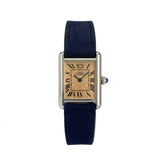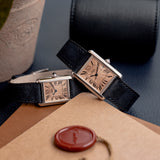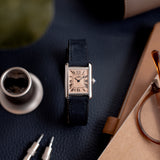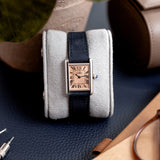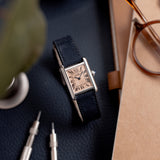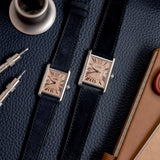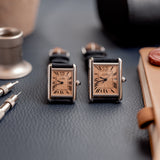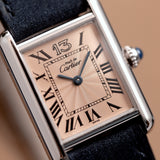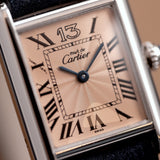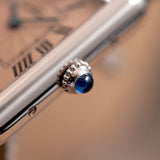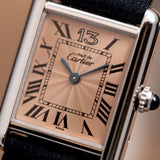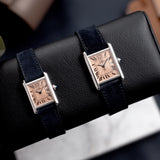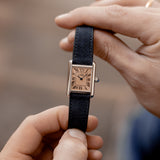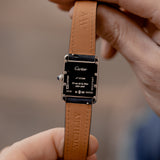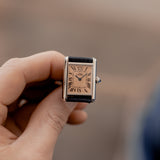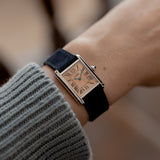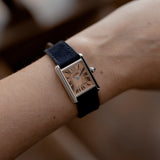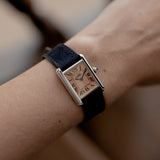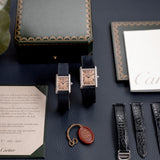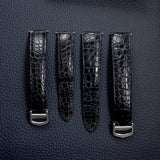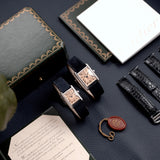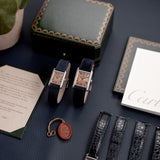Cartier Must de - 13 Rue de la Paix - Guilloché Salmon dial - Ref. 2416 Small model
History of the Paris boutique and the watches
Simply a must. No should, could, would, might or may about it. Just a sparkling, crystal clear - must!
Life is never simply plain sailing, if it were - it wouldn’t be half as much fun. The journey of iconic, time-defying brands is no different; there are the glorious moments of unadulterated success and then there are those other moments, when crisis hits. It is not about if the crisis will hit but how it is faced when it does: give in and give up, or go with the flow of where it leads.
In the late sixties, early seventies such a crisis struck Cartier. Pierre Cartier, who had led the New York wing of the enterprise and played a key role in the business, died in 1964. He was the last of the three brothers who had propelled the brand to international success to pass away, the Cartier brand was flying high but without any of its first-rate pilots. Some turbulence and a loss of altitude were bound to ensue. The children of the three brothers would ultimately decide to sell the businesses. In 1972, Cartier Paris was bought by Robert Hoch and Joseph Kanoui, who were tasked with finding the path back to Cartier’s former glory.
They had a brand with a world-renowned name, great heritage and desirable products but something was not working. Within watchmaking, they had a second hurdle to overcome - the quartz crisis. This sudden influx of affordable, battery-operated, highly-accurate timepieces spelled disaster for the intricately-made, distinctly expensive, manual Swiss watches. Cartier had a decision to make, try and resist the tidal wave of change that was to turn everything upside down or embrace it - own it. Luckily, Cartier opted for the latter. Under the direction of Alain Perrin, Les Must de Cartier were launched. A collection of less expensive and thus more accessible pieces that one simply must have. With the Must de Cartier Tank, the instantly recognisable prestige of the Cartier Tank was adapted for a new market, it was produced using less expensive materials and with a quartz movement, leading to a lower price point and thus, new customers. An ingenious move.
The collection was a roaring success. Even Yves Saint Laurent sported a Must de Cartier Tank. An innovative symbol of survival. A key piece of Cartier’s history.
The two Must de Cartier Tanks we have at hand here however, have an extra glimmer of historical value. They were both released to mark the grand reopening, after extensive renovation works, and 100th anniversary (1899 -1999) of the famed Cartier boutique in 13 rue de la Paix, Paris. These were not the very first premises Cartier occupied but they are undoubtedly the most pivotal and precious to the Cartier story. It was Louis Cartier, one of the main catalysts for Cartier’s success, who would convince his father to move their shop to Rue de la Paix in 1899. It was here where the brand would truly take root, in the refined elegance of central Paris. This would be home. 13 rue de la Paix would bear witness to all the significant comings and goings of the brand as it grew; the very first wristwatches were made here, Louis Cartier and Jeanne Toussaint would establish their offices here (which are still preserved to this day), numerous celebrities, royalty such as Grace Kelly would make a point of visiting the boutique in 13, rue de la Paix.
It became the place to truly connect with the magical world of Cartier. The almost complete collection of Cartier wristwatches can be viewed here. In early 2021, the boutique was closed once again due to renovation work but from the way in which it was closed, it is possible to understand just how treasured 13 rue de la Paix is. Not satisfied with just a simple façade to cover the building works, Cartier commissioned an exact replica of the actual façade of the building in order to shield the renovation. The replica took over a year to create, involved architects, artisans, artists, engineers, sculptors, painters and an absolutely remarkable attention to detail. It is quite clear that still to this day, 13 rue de la Paix is an unreservedly cherished part of Cartier.
The watches
In 1999, to celebrate the boutique’s centenary and mark the event in a suitable fashion, Cartier launched not just one but four limited edition anniversary watches. A Cartier Tortue Monopoussoir and a Cartier Driver, both with a salmon dial and each one limited to just 13 pieces in honour of number 13, rue de la Paix. These two pieces were launched together with the two Must de Cartier Tank limited editions that are presented here.
One large and one small, both versions limited to just 100 pieces which is engraved on the caseback. The large, with ref. 2414, measures 25.5 mm x 34 mm. It has a sterling silver case and date function placed at 3. Look closely and it is possible to see the Cartier secret signature at 7, whilst the dial signature reads must de Cartier.
The small, with ref. 2416, also has a sterling silver case and measures 21.8 mm x 29.3 mm. Look even more closely on this one to see the Cartier secret signature at 10, a charming touch. There is no date function on the small watch but the must de Cartier signature remains.
Both have sword shaped blue steeled hands. The large, differing from the small, also has a centre sweeping blue second hand. Each has the trademark Cartier railway track minute markers and elongated roman numerals.
However, there is one very poignant and celebratory difference. At the 12 we see the outline of an arabic 13, a gracious homage to 13 rue de la Paix. The celebration continues across the highly-collectable salmon coloured dials as each dial is fabulously and entirely covered in rosette guilloché, emanating into every corner. A complicated and intricate decorative technique that involves very fine, patterned engravings applied by exceptionally skilled artisans, the guilloché quite literally allows for these pieces to shine.
Turning from the stunning watch face to caseback, we see the third element of celebration. The elegant engraving - 13 rue de la Paix, 1899 - 1999, further underscoring the historical significance of these pieces.
Two pieces which encapsulate two diverse moments in Cartier’s history, one of overcoming adversity and one of unbounding jubilation.
Two truly exquisite gems of Cartier heritage.
Movement
Both pieces are powered by a Cartier quartz movement.
Set and condition
Both are in excellent condition.
The large watch comes with its original steel Cartier folding buckle, original green Cartier box as well as papers, certificate and manual. The original strap from 1999 is included. The watch is fitted with a Mr Watchley navy blue nubuck strap.
The small watch comes with its original steel Cartier folding buckle but no box or papers. The original strap from 1999 is however included. The watch is fitted with a Mr Watchley navy blue nubuck strap.
If you desire to take a closer look at this precious timepiece, don't hesitate to contact us and make an appointment. Viewings by appointment only
We are based in Ghent, Belgium
No stock kept on site
| Reference | 2416 |
|---|---|
| Movement | Quartz |
| Caliber | Cartier |
| Dial | Salmon Rosette Guilloché |
| Size (Case) | 21,8 mm x 29,3 mm |
| Material (Case) | Silver |
| Bracelet | Mr Watchley Navy Blue Nubuck |
| Glass | Sapphire |
| Condition | very good |
| Year | 1999 |
| Papers | - |
| Box | - |
| Warranty | 2 years |

